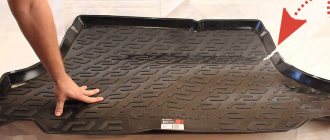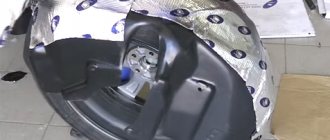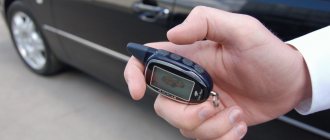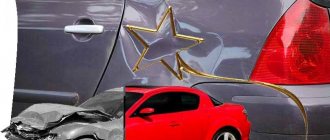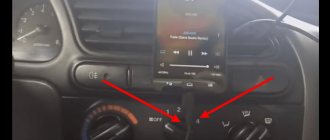At the first practical driving lesson, a beginner is introduced to the location of the pedals in the car. In the process of learning and further driving practice, the ability to automatically, without thinking, manipulate car controls, which include pedals, largely determines the professionalism of the driver. But at first, it is advisable not only to know how the pedals are located in the car, but also to understand what happens when they are pressed in the mechanisms - this makes it easier to develop those qualities that can later be characterized as how you “feel” your car. And if you develop them, then maybe this will someday save not only yours, but also other lives. Despite the fact that modern cars have active safety systems, you should not rely on them completely. Moreover, in aviation, the excessive equipment of passenger aircraft, the so-called “fool proofing”, leads to the fact that in a critical situation the pilot is not able to make a decision that could avoid a disaster. And even if such a decision were made, the automation simply blocks the pilot’s actions, depriving him of the ability to control the equipment.
The location of the pedals on the “mechanics” - where is which pedal in the car
Using the machine's pedals
Where are the gas, brake and clutch pedals? On a car with a manual transmission, it is customary to arrange the pedals as follows (from left to right): clutch pedal, brake pedal, gas pedal. Let's take a closer look at their work.
Where is the clutch pedal located and what does it do?
The clutch pedal is on the left. It serves to separate the engine and gearbox. To start smoothly, you need to do the following (the engine is running):
When starting off, smoothly release the clutch pedal while gently pressing the gas pedal.
- press the pedal, while the driving and driven clutch discs, pressed against each other, are separated and torque from the engine ceases to be transmitted to the gearbox. That is, the gearbox input shaft connected to the driven disk stops;
- engage first gear;
- smoothly release the clutch pedal while gently pressing the gas pedal.
If the car is on the parking brake, “toward” the slope of the road, then the task is complicated by the fact that at the moment the car starts moving, you need to remove the car from the brake. This skill is developed through practice. In general, in order to better feel how the clutch works when starting off for the first time, practice on a road with a slight downward slope - then you can not touch the gas pedal when starting to move - the engine will not “stall” if you are careful . The clutch pedal also serves for smooth gear changes while driving. In such cases, on the contrary, it is necessary to press and release this pedal quickly - in order to avoid their slipping relative to each other at the moment of connecting the clutch discs - otherwise the friction linings will “burn out”.
What does the brake pedal do and where is it located?
The brake pedal is located in the center - between the other two. It would be unnecessary to tell what it is intended for. We can only add that the braking system of the car is equipped with a brake booster, and if braking requires a significant amount of pressing force on this pedal, then it is necessary to check the car at a service station.
Gas pedal - which side it is located on and its functions
It is located on the right side. Serves to increase the supply of fuel to the combustion chambers, which allows them to be increased or decreased at the discretion of the driver. The most common cable drive is the throttle valve, which, when installed in the intake tract, opens or closes it. Both the damper and the gas pedal are equipped with return springs, which return the control mechanism to its original position when the driver stops pressing the pedal.
The location of the pedals themselves in a right-hand drive car is the same as in a “regular” one with a “left-hand drive”.
In order to learn how to skillfully control this pedal, “work” it when the engine is running and the car is on the parking brake. The gas pedal, as a rule, does not provide much resistance to the foot, so you need to handle it carefully. Driving instructors used to advise imagining that there was a raw chicken egg between the pedal and your foot - in order to more clearly demonstrate to the student how careful they need to be. So, we figured out the order of the pedals in the car. If you have to get behind the wheel of a right-hand drive car, the only thing that will change is that you will sit on the right side of the passenger. You will have to change gears not with your right hand, but with your left hand. And the location of the pedals themselves in a right-hand drive car is the same as in a “regular” car - with a “left-hand drive”. But on our roads, driving such a car will cause you a lot of inconvenience - the entire road infrastructure does not provide for such a driving position. The overtaking procedure will be especially unpleasant.
How are the pedals located on the mechanics?
When you get into a car equipped with a manual transmission, you will see three pedals in front of the driver's seat. The first one, the one on the far left, is called a clutch. It serves to transmit torque to the wheels, thereby forcing the car to move. The clutch pedal is also used when changing gears. She presses with her left foot.
The brake pedal is located in the middle. Please note: it is controlled only with the right foot! Allows you to smoothly (or sharply during emergency braking) reduce the speed of the car.
On the right edge is the gas pedal. Pressing it causes the car to move. The harder you press, the higher the speed.
How are the pedals located in a car with an automatic transmission?
The location of the pedals in a car with an automatic transmission
On a car with an automatic transmission (automatic) there is no clutch pedal; the brake and gas pedals are located in the same way as on a manual transmission, but for convenience the brake pedal is larger. The limit switch located on the brake pedal of an automatic transmission is somewhat more complicated - it serves not only to turn on the brake lights, information about the impact on the pedal is also transmitted to the engine ECU and ABS, as well as to various other active safety systems (for example ,ESP).
Engine starting is blocked if the brake pedal is not pressed on a car with an automatic transmission.
Engine starting is blocked if the brake pedal is not pressed on a car with an automatic transmission. Starting off, compared to the “mechanics”, is simplified - just move the selector to the “D” or “R” position (for reversing) and release the brake pedal. When starting uphill, you can simply press the gas a little harder. In any case, the car will not roll back, it will simply not move forward if the rolling resistance is slightly higher than a certain value. A comfortable seating position for the driver is also important – so that operating the pedals does not cause inconvenience. In addition, it is advisable to adjust the pedals so that they are at the same height. Don’t forget about safety - sometimes a mineral water bottle that rolled under the pedals caused an accident. Also, carefully choose interior mats - their pattern can “cling” to your shoes, which will irritate and distract attention. The same applies if chewing gum or grease gets on the surface of the pedals. As they say, “there are no trifles in technology.”
In what order are the pedals located in any car?
- Gas pedal. Any car is equipped with this pedal. It is located on the right and is operated by the right foot. Responsible for the start of movement and acceleration. By pressing it, we give the car a signal that the system should increase the supply of the air-fuel mixture. By releasing the pedal, we give the reverse “setting”, i.e. We notify the mechanism about a decrease or cessation of fuel supply. Roughly speaking, the gas pedal is something like a faucet lever that can be opened or closed;
- Brake pedal. Also available in every car and located on the left. However, just like the gas pedal, it is operated exclusively by the right foot (you should pay close attention to this during the learning process!). In cars equipped with an automatic transmission, this pedal is located in the middle, to the right of the clutch and to the left of the gas pedal. By activating it, we give the car a signal to gradually or sharply (in emergency situations) reduce its speed. The brake is the main part of every car! It is more important than the clutch, the gear shift lever, and even the gas! The fact is that getting moving, starting to move, changing gear or accelerating is not so important. But you must stop in any case when there is such a need or desire. Moreover, in some situations on the road this may need to be done urgently;
- Clutch pedal. This part is only available on vehicles with a manual transmission. It is located on the left (the brake in the “mechanics” is in the middle), and is activated exclusively by the left foot. It serves to switch torque to the wheels, thereby driving the car. It is pressed all the way and then released smoothly. By performing this manipulation, you force the car to move away. This needs to be done as smoothly as possible. Also, using this pedal, you can change speeds on the gearshift rocker.
This is the classic structure of the pedals in a car equipped with a manual transmission. Driving such an “iron horse” is quite difficult. In any case, it’s more difficult than an automatic machine. However, experienced drivers consider it “the basis of the basics”, and they say that your journey in driving a car should begin with precisely these basics.
Only if you master the “mechanics” will you be able to handle any other car. If you start right away with the “automatic”, it will undoubtedly be easier for you.
But you cannot become a truly high-quality driver. Moreover, it is very difficult to relearn from an “automatic” to a “manual”, and this adaptation can be equated to learning “from scratch”.
Pedals in a car - location and principle of operation
Pedals are a very important element of driving a car. Because thanks to them, the car starts moving, stops and slows down, and regulates the speed of the car. A beginner and even an experienced driver need to get used to the place where they are located.
So, when driving a car for the first time, every driver will definitely find a comfortable seating position by adjusting the driver’s seat. Due to varying heights as well as seating preferences, this must be done before moving.
In many ways, the convenience of the driving position influences both premature fatigue and the comfort of the trip in general.
How do pedals work and what functions are they responsible for?
Each of them performs its own function, but their operating principle is the same. Their involvement in control occurs by pressing and releasing. Different situations and different pedals have different modes of use.
Gas pedal
This control serves to increase engine speed.
Its activation is necessary:
- if you start moving,
- acceleration speed regulation,
- in case of acceleration in motion,
- and other cases related to maintaining speed limits.
Brake pedal
This control exists to slow down the vehicle.
Involvement is possible in the following cases:
- braking,
- reducing speed (deceleration),
- making a stop,
- maintaining the speed limit (for example, maintaining the required speed when descending from an inclined area).
Clutch pedal
This control serves as an assistant from the start of movement until the vehicle comes to a complete stop.
It is necessary when:
- need to start moving
- when accelerating, you need to shift to a higher gear,
- in case of downshifting.
Gear shift lever (yoke)
The gear shift lever (shift lever) is a vehicle control element, the purpose of which is a more rational distribution of torque from the engine to the driving wheels of the car.
It is present in cars with:
- manual transmission,
- automatic transmission.
It can be of different colors and shapes, but is present in any car in one form or another. This device may be called a gear selector. Thanks to him, the car starts to move.
Accommodation options may vary:
- on the steering column in the form of a lever located on top behind the steering wheel (this arrangement is typical for cars on the North American market),
- on the steering column, in the form of under the steering switches, which are located behind the steering wheel, closer to the dashboard,
- on the floor in the central tunnel, in the form of a handle protruding from the floor or a center console located between the front seats.
How are the gas pedal, brake and clutch located in a car?
How are the gas pedal, brake and clutch located in a car?
As everyone knows, the gas, brake and clutch pedals are located in the car as follows. On the left side there is a clutch pedal, then there is a brake and the rightmost gas pedal. In cars equipped with an automatic transmission, there are two brake and gas pedals.
Since I have been driving since 2009, I can tell you how and where the pedals are located. The pedals in the car are located on the driver's side, at the driver's feet. If you look from left to right, the clutch comes first, then the brake (middle pedal), and lastly the gas.
Well, if the driver is sitting on the left, then on the left side of the car, if on the right, then on the right. The one closest to the window is the clutch (only available with a manual transmission), then the largest is the brake pedal, and then, smaller, the gas pedal.
The clutch pedal is on the far left. The brake pedal is located in the center. The one on the far right is the gas pedal. This is in a car with a manual transmission. In a car with an automatic transmission there are only two pedals: the left one is the brake, the right one is the gas.
How to properly drive a car with a manual transmission?
To drive a car with a manual transmission, you need to know and master the basics of driving practice.
This includes:
- knowledge of the location and order of gear shifting,
- the ability to start moving smoothly, without jerking,
- skills of accurate and consistent gear shifting,
- coherence in the work of arms and legs when changing gears,
- ability to brake the engine,
- ability to move in reverse,
- the ability to start moving uphill without rolling back,
Having all these skills and constantly honing their coherence, you can achieve proper driving.
At the same time, practice shows that the more often and longer you spend time driving, the sooner your actions become automatic. Subsequently, all acquired management skills become subconscious and are carried out clearly.
Which car to choose - “automatic” or “manual”?
Disputes and verbal battles on this topic have been going on for a long time. Some are attracted by the opportunity to save fuel by using a manual transmission, while others are exhausted by everyday traffic jams with regular switching of the first three or even two gears.
In view of this, the latter advocate exclusively for automatic transmission. Here everyone makes a choice independently and based on the skills that were acquired at the stage of learning to drive.
Advantages of a manual transmission:
- Simplicity of the device.
- High maintainability.
- The ability to reduce costs associated with refueling a car.
- Smaller size and weight.
- There is no need for a tow truck when towing.
- Relatively long service life.
Advantages of automatic transmission:
- Easy to use.
- The gearbox itself will select the optimal shift point.
- The ability to easily start moving uphill without rolling back.
- No need to constantly work with the left leg.
- Minimum gear selection (drive, neutral, 1st and 2nd gears, semi-automatic mode, reverse gear, parking mode).
- Quick adaptation to driving style
Using a pedal assembly in a car with any type of gearbox is a necessity. At the same time, there are still differences between the pedal assembly on a car with a manual transmission and a car with an automatic transmission. The convenience of each of them is a purely individual evaluative concept.
You can only check which of them will be more comfortable by driving vehicles with both types of gearboxes alternately for a long time.
Arrangement of pedals in the car: 2 types of design
When learning the rules of driving a vehicle, young car owners become familiar with how the driver's seat is arranged. One of the main control methods is pedals.
The order of the pedals in the car
The location of the pedals in the car depends on the type of transmission. The first cars were equipped with a manual transmission.
The first prototype of levers appeared on the famous Ford T. At that time, the ignition system was turned on with a button.
The pedals were located under the steering column. There were three of them:
- On the left side, it was responsible for the clutch.
- In the middle - needed for reverse
- On the right - used for braking.
Manual transmission
The pedal arrangement in a manual car is designed as follows:
- left – clutch;
- in the center - brake;
- on the right side is gas.
First of all, the driver should determine where the brake and clutch pedals are located. The fact is that in a manual car, braking requires pressing two pedals at once. Experienced drivers say that the clutch should be pressed a second earlier.
To start moving, you need to release the clutch. It should be remembered that the clutch pedal in a car with a manual transmission is pressed only with the left foot. It’s not worth keeping your foot on it all the time: it will get tired so quickly, and the clutch itself wears out faster, since it is constantly under increased load.
In order for the vehicle to start moving, the lever is first pressed all the way, then smoothly released.
Automatic transmission
The location of the pedals in a car with an automatic transmission is slightly different. There are only two levers: gas and brake. The pedal arrangement in a car with a manual transmission is the same.
The brake in the car is necessary to stop the vehicle in a timely manner. When you press it, the brake lights come on immediately.
In a car with an automatic transmission there is a parking brake lever, which is also called a “scissor”. It is located on the left and is used instead of the handbrake. Smooth pressing on it leads to fixation of it with a ratchet, like the car itself.
The gas pedal or, as it is also called, the throttle control pedal is located in both types of cars. It is necessary to regulate the method of movement. The more you press on it, the more the engine speed increases and the speed increases.
It is located closer to the bottom. In addition, its shape is narrower. When they stop pressing on it, it returns to its position.
These pedals in the car are located like this:
- on the right – there is gas;
- on the left side - braking.
Car owners should remember that both pedals in the car are controlled only by the right foot.
The left one is used solely for traction, which is why some cars have a footrest. Since the right leg is used more, there is no support for it, even if the vehicle has cruise control.
If your car has an automatic transmission, you should not try to press both levers at once, as this will damage the gearbox.
Regardless of which gearbox is installed in the car, you must press down on the levers smoothly, without sudden movements. Of course, unless you need to brake urgently.
The pedals can be installed either hanging or floor-standing. It is believed that if they are on the floor, it will be more convenient for the driver.
Pedals in a training car
Every car enthusiast was trained at a driving school before receiving a driver's license. A mandatory step is driving a car. According to the rules, special requirements are imposed on it.
If the vehicle is equipped with a manual transmission, then it must be equipped with additional clutch and brake levers. This is done so that the instructor can take control if necessary.
Duplicate pedals are manufactured and installed separately for each brand of car. The type and size vary by brand. The design contains both two and three levers. In addition, their location can also be different - on the left or on the right.
They work independently of the standard levers. The design allows them to be quickly dismantled or rendered unusable. This is necessary in order to exclude the possibility of use by a passenger.
How are the pedals placed in a right-handed car?
Some manufacturers make right-hand drive cars. Of course, they are designed for driving in countries that drive on the left. Many people believe that the pedals, like the steering wheel, are mirrored. However, it is not. The pedals are located in the car in the same order as in a car with a left-hand drive. The only difference is the driver's position.
What pedals are there in the car, and what is the order in which they are located?
When choosing a car, buyers pay special attention to ergonomics and ease of driving. Controls include not only the steering wheel, but also the gearbox and the pedals used in the car. When placing pedals in a car, all automakers adhere to generally accepted standards.
It is also interesting that on identical machines their number may differ. This directly depends on which gearbox is provided in a particular configuration. On manuals there are more control levers, on cars with automatic transmission there are fewer of them, since the need for one of the pedals disappears.
The first cars were equipped exclusively with mechanical transmissions, which made it possible to control the behavior of the car and its speed. Drivers accustomed to manual transmissions note that the mechanics allow you to fully feel the car, thereby feeling like you are in charge.
Then came automatic transmissions. Working with them has become much easier. Yes, many may argue that mechanics are the basis, and only such a box makes it possible to get the most out of the car. Currently, it is not necessary to know how to operate a manual transmission if you buy a car with an automatic transmission.
The location of the pedals in current cars
On current cars that receive a license for mass production, there is a standard pedal position mode, which is regulated separately for cars with manual and automatic transmissions. If a model violates these rules, it will not receive approval for sale to consumers.
That's why in an automatic transmission we have two pedals - the brake on the left and the gas on the right. On a manual transmission, a clutch pedal is added to the left. The distance to the pedals and their lifting height may vary in cars. The advantages of such standardization and the same location of the main controls are obvious:
- the driver does not have to get used to the new car for a long time;
- you can easily use different car models;
- there is no dangerous period of getting used to the controls;
- the driver only needs to obtain a license to drive any car in a certain class;
- The control system of all machines has the same tendencies.
This allows us to easily change cars, buy new vehicles and drive company cars. Today, not every driver can imagine how to change the location of the pedals in a car to make driving even more convenient. Therefore, the current features are considered optimal and safest.
It should also be noted that manufacturers do not yet have the right to change the features of the location and presence of pedals in cars, although many already have certain technologies that allow this to be done. Soon everything may change, and we will be owners of cars with new handling patterns.
Functional Features
Having studied the features of the location of the pedals in cars with a manual transmission, it will not be difficult to finally remember where each is. Each of you understands that the pedals in the car play a certain role. Everyone has their own strictly assigned function. And they need to be taken into account when getting behind the wheel.
Let us remind you how the pedals in any car go from left to right on the driver’s side:
- clutch;
- brake;
- gas.
In an automatic transmission, everything goes exactly the same way, but only with the condition that there is no clutch in this sequence.
To better understand the functional features, you need to consider all the pedals separately.
Clutch
It's easy to remember where the clutch lever is located in your car. It is important to take into account that on all cars they are always in the same place. Car companies cannot place the clutch on the right or in the middle.
Now let’s talk more specifically about why such a control lever in a car as a clutch pedal is needed. Responsible for the connection between the gearbox and the engine, as well as disconnection as necessary. If the pedal is not touched, the engine will be connected to the gearbox, that is, at this time the clutch is considered to be engaged.
When the control lever is pressed to the floor, disengagement occurs and therefore the clutch is disengaged. In order for the car to start moving, the driver must turn the clutch back on. And to do this, simply release the pedal.
If you take into account the design, everything happens as follows:
- the clutch disc consisting of a pair of discs is located on the splines of the input shaft of the box, a rigid connection is used;
- in this case, the disk is clamped between the motor flywheel and the basket rings;
- when the pedal is pressed, a special spring releases the ring located on the basket;
- the ring moves away from the flywheel;
- the disk is released and it begins to rotate independently of this flywheel;
- now the driver changes gear and then releases the pedal;
- at the same time, the spring is released by the release bearing, the rings come back together, and the disk is clamped again.
This happens quickly and cyclically with every gear shift on a manual transmission.
When operating a car with a manual transmission, that is, if there is a clutch in the form of a pedal, you must adhere to some rules:
- You should always keep your left foot near the pedal so that you can press it at any time. Most cars are equipped with platforms to the left of the pedal, which is intended for the left foot and its rest between shifts. The main thing is to take a comfortable position so that your leg does not get tired.
- You don't have to keep your foot on the pedal all the time. Otherwise, the driver gets tired and the clutch itself wears out faster. Any even slight pressure creates a load, and therefore wear occurs.
- Always depress the control lever fully when changing from one speed to another.
- The left foot is used only to operate one pedal. And it's purely clutch.
- Pressing should be done completely, quickly, but without jerking. Try to do everything in one movement. This is where how comfortably you hold your foot comes into play.
- When you smoothly release the pedal, traction begins and the car moves. At this moment, you should stay in this position and drive literally 3 meters. This holding of the leg in the middle position is the optimal starting point. If you miss this moment, sharply remove the pedal or press the gas too quickly, you will end up slipping, the car will start to twitch and will probably stall. It is recommended to practice the start as much as possible. You need to get used to each specific car.
- Be sure to disengage the clutch before starting the engine. To do this, the pedal is pressed to the floor. Only then does the starter turn on.
- The clutch is used in three situations. This is the start of movement, switching gears and stopping completely.
It is the clutch that makes driving cars with manual transmission more difficult when compared with automatic transmission. But you get used to everything and you can learn everything.
Having the skills to control a manual transmission with a clutch pedal, switching to an automatic transmission will not be difficult. But if you learned to drive an automatic transmission, and then had to switch to a manual transmission, you can feel as if you were behind the wheel for the first time.
Brake
You already know where the brake pedal should be located in the car. If in a car with a manual transmission, then in the middle, and if with an automatic transmission, then on the left.
By pressing this control lever, the driver thereby transfers the load to the amplifier. It creates additional force on the master brake cylinder installed in the car. By releasing the pedal, the return spring allows you to return the element to its original position.
There is nothing complicated in the design of this component. This is a lever with a special platform for the foot on the bottom side. There are also a couple of holes near the top end. Through one hole passes a pin that allows the pedal to move back and forth in a confined space.
The second hole is needed to connect the vacuum booster to the plug. If there is no booster, then there is a connection to the master cylinder of the brake system. To create a reliable and movable connection, metal pins are used.
When the driver presses this pedal, any car is designed to automatically turn on the brake lights located behind the car.
How to operate the pedals
The arrangement of two pedals in a car with an automatic transmission reduces the load on the driver. Less focus on management required. Legs get less tired. But you need to know some features of the brake and gas operation in an automatic machine:
- The gas and brake must be pressed smoothly so that the car has time to react smoothly.
- You need to switch automatic modes with the brake pressed.
- When a car with an automatic transmission is slipping, pressing on the gas is harmful. To get out, you can try using the pedal as a clutch in a downshift, slowly rotating the wheels.
- In Drive mode, “playing” with the gas changes the automatic gears: if you press the gas 2/3 during acceleration, the engine will spin up in this gear without shifting higher. To downshift, you need to quickly press the gas and release slightly.
- In manual mode, releasing the throttle at low speed puts the torque converter into fluid clutch mode. The car is braked by the engine, which is convenient for rough city driving - the foot brake is used less.
- You need to sharply turn off the gas in the “Kick-down” mode. In this case, the automatic switches to 1-2 speeds for overtaking. Frequent use of the aggressive gas mode harms the box.



